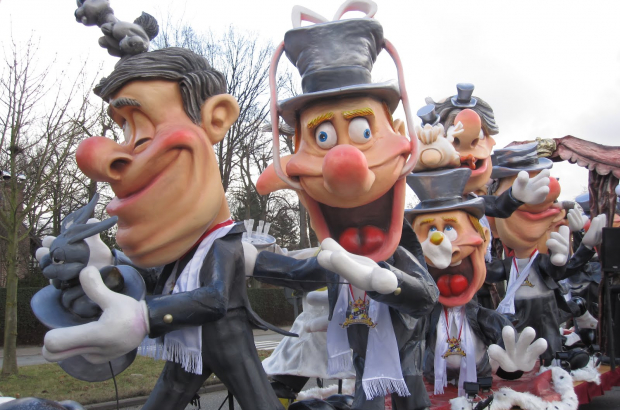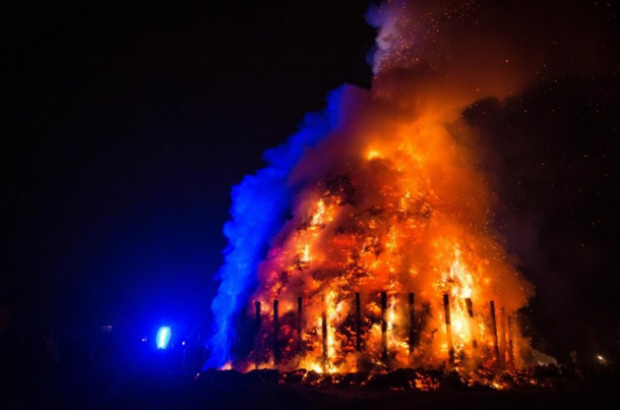- Daily & Weekly newsletters
- Buy & download The Bulletin
- Comment on our articles
It's our party: The history behind Belgium's extravagant Carnival celebrations
Carnival is an important part of Belgian cultural identity. With some traditions like those of Binche and Aalst recognised as world heritage by Unesco, it’s no surprise that these celebrations are yearly highlights that attract thousands of visitors.
The festivities are centred on Shrove Tuesday (Mardi Gras in French, Vette Dinsdag or Vastenavond in Dutch), which is traditionally the day when people dress up and go out in the streets to party. In fact, Carnival is the name given to the three-day period before the start of Lent on Ash Wednesday. Carnival is thus a Christian celebration, albeit with a hint of lingering paganism. Some say it partly goes back to heathen rituals that celebrated the end of winter.
Besides the Shrove Tuesday festivities, Belgium has a tradition of hosting Carnival parades during Lent. This might seem strange, but since these parades take place on Sundays, which are not comprised in the 40 days of abstinence, drinking and feasting are perfectly fine. The Blancs-Moussis parade in Stavelot, for instance, takes place on Mid-Lent Sunday, while all over Limburg Carnival parades will take to the streets during this time.
As if this doesn’t already make for quite a long period of partying, the Carnival year can actually start as early as 11 November. At precisely 11.11, the Councils of Eleven in some towns convene to open the Carnival year and start planning the festivities. So you could say that Belgians actually celebrate Carnival from November until Easter. That should tell you something about its cultural importance.
Carnival historically served several purposes. First there was the practical side. Celebrations involved excessive eating and drinking, because during Lent various foods like meat and eggs were banned. In many places it’s still traditional to eat pancakes on Shrove Tuesday – an excellent way to use up all those eggs.
There was, however, a deeper meaning to these traditions in past societies. Carnival was all about the reversal of the normal order. Before the French revolution of 1789, society was ordered through the strict hierarchy of the three estates: the common people (in Belgium mostly represented by urban populations), the nobility, and the clergy. Your rights within society were determined by your estate, and for many people that meant a life in which there was little room for personal freedom.
Frustrations about that were vented in these celebrations. For one short – albeit strictly determined – period of time, there was no hierarchy. As early as the 16th century the authorities tried to subdue the more violent and excessive side of celebrations, to turn it into a more regulated festival. But although the festivities were slowly channelled into something more controllable, Carnival remained an important yearly outlet for a lot of people.
Despite the many origin myths in local folklore, the Carnival traditions in Belgium today all date back to the 19th century. Many of the costumes, rituals and parades that are so popular today were established by the end of that century.
They do, however, still echo the old rituals and ideas. The Gilles of Binche demonstrate that particularly well. The loud and obtrusive music and noise they produce chase away winter and awaken spring. They act out a ritual storming of the city hall as if to defy the authorities, and they drink champagne and throw oranges into the crowd. Although the rules for this feast are very strict, they still hint at the reversal of the normal order by concentrating on luxurious food and drink.
Whichever tradition you favour – little Belgium boasts several – the important thing to remember is that Belgians take the business of Carnival seriously. Locals will appreciate your participation, but not your mockery!
Mirella Marini, Belgian Academy of Culture and History. This article first appeared in The Bulletin winter 2017. Browse the magazine here, pick up a copy in newsagents or subscribe today...

Six of our favourite Belgian carnivals
Aalst, 11-12 February
The most famous carnival celebration in Flanders is in Aalst. The three-day event was recognised as a Masterpiece of the Intangible and Oral Heritage of Humanity by Unesco in 2010, but the tradition goes back to the middle ages. The main parade on Sunday features, in addition to floats and beautiful costumes, satirical depictions of politicians and other public figures and a great deal of lewd and raunchy humour. The fun continues on Monday with an abbreviated version of Sunday’s parade and the appearance of the Gilles of Aalst – men in distinctive historical costumes who perform age-old rituals to ward off evil and welcome spring.
Binche, 11-12 February
This Unesco-recognised carnival is one of Belgium's most famous, dating back to around the 14th century, but the exact origins are unclear. The folkloric event includes up to 1,000 clown-like performers called Gilles who are wearing masks and dressed extravagantly. On the final day oranges are thrown at the crowd of people in attendance. Check out this one for lots of music, dancing and tradition.
Stavelot, 10-12 March
Falling in the middle of Lent, this festival is three days of celebration and strange traditions. On the Sunday of the carnival the streets of Stavelot will be filled with characters known as the Blancs-Moussis. These unusual characters dressed in white and wearing funny masks carry dried pig bladders and hit people on the head with them. Pay attention or one of them may stuff confetti down your back. Stavelot residents turn out in their droves dressed as clowns, penguins and pirates or in traditional dress of the area, joined by floats and marching bands.
Carnival of the Bears, 11 March
This carnival celebrates the legend of a nine-year-boy who was rumored to have killed a bear in Andenne. There’s a huge parade celebrating the bear, which is now the mascot of the town. There’s dozens of floats, tons of confetti and a ceremonial throwing of teddy bears off the town hall balcony.
Blankenberge, 10-13 February
An annual occurrence since 1952 with a carnival ball, the appointment of Prince Carnival, a children’s carnival and fireworks on the beach, this carnival is well worth a visit.
Knokke-Heist, 10-13 February
This carnival begins with a mass to fishermen lost at sea and continues with a parade featuring giant puppets Pier and Wanne. Monday is Sprotjesdag when cafes hand out free sprats. Tuesday kicks off with a costumed football game between the Vissers (fishermen) and Plakkers (plasterers), a tradition that dates back to 1928. The festivities end with an evening procession through the town centre.

Wallonia lights fires to chase away winter
Wallonia’s carnival traditions extend to chasing away winter spirits by burning giant bonfires. The biggest and most spectacular of them all is the giant fire of Bouge, overlooking the Mosane valley in Namur. Flames light up the sky in front of a crowd of thousands in a ceremony dating over 1,000 years.
The pagan belief is that the burning ritual marks the end of winter, making way for the return of spring and the season of fertility and growth. In the commune of Bouge, a local brotherhood has been maintaining the tradition for the past 60 years. It starts building the bonfire in November, collecting fir tree branches and discarded Christmas trees, before lighting the blaze on the first Sunday of Lent. Atop the fire they place a symbolic figure of Don Juan of Austria, the son of Charles V who died in Bouge in 1578.
After an official sermon in the Walloon dialect and a procession of the brotherhood, festivities include flamethrowers and warming refreshments; mulled wine, local beers, pancakes and hotdogs.
Bouge: 18 February
Aische-en-Refail (Eghézée, Namur province): 10 February
Falisolle (Sambreville, Hainaut province): 17 February
Morlanwelz (Hainaut province): 19 February
La Roche-en-Ardenne (Luxembourg province): 23 February









